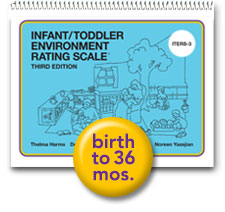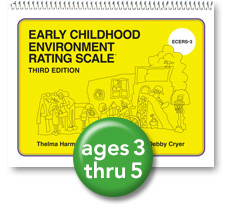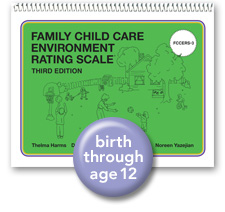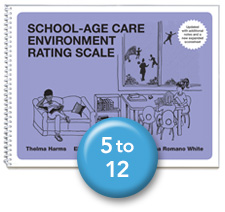Environment Rating Scale (ERS) Overview
Quality Assessment & Improvement Tools for Early Childhood Programs
The ERS Family of Products are the leading research-based tools to assess the comprehensive quality of early childhood programs, and for over 40 years, they continue to be the premier instruments in the field for reliability. The ERS are widely used in the U.S. and abroad to guide continuous quality improvement initiatives and to optimize the quality of early learning opportunities for young children.
Tailored to specific age groups and early learning settings, each ERS scale is designed to evaluate process quality. Process quality is what children directly experience in their programs, which has a direct effect on their development.
There are four ERS scales. Now in its third edition, the Early Childhood Environment Rating Scale® (ECERS-3) is designed for preschool and kindergarten classroom observations. The Infant/Toddler Environment Rating Scale® (ITERS-3) is for center-based infant and toddler program observations. The Family Child Care Environment Rating Scale® (FCCERS-3) is for home-based family child care program observations. The School-Age Care Environment Rating Scale® Updated (SACERS) is created for programs caring for school-age children during out-of-school time.




The ERS are widely used for: State and District-wide QRIS, Continuous Quality Improvement, Universal Pre-K Systems, Head Start programs, Culturally Diverse and Inclusive Programs, Teacher Self-Evaluation, Professional Development and Coaching, Early Childhood Education Courses, and Longitudinal Studies.
“The scientific evidence linking process quality (as measured by the ERS) and child learning and developmental outcomes is compelling….”
—CampbellCollaboration review, January 2017
Suitable for use in inclusive and culturally diverse programs, ERS subscales and Items evaluate:
- Teacher-Child Interaction
- Health and Safety
- Physical Environment
- Curriculum
- Program Structure
The ERS provide insight into a program's global quality and encapsulate key aspects of an early learning environment that are important to optimizing children's development.
Based on extensive research and field testing, the ERS tools have established inter-rater reliability and validity, making them especially useful for accountability and program evaluation, in addition to professional development, program improvement initiatives, longitudinal studies, and research.
ERS® and Environment Rating Scale® are registered trademarks of Teachers College, Columbia University.





